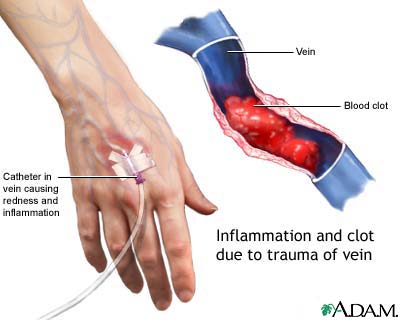Health Library
Superficial thrombophlebitis
Thrombophlebitis - superficial
Thrombophlebitis is a swollen or inflamed vein due to a blood clot. Superficial refers to veins just below the skin's surface.
Images


I Would Like to Learn About:
Causes
This condition may occur after injury to the vein. It may also occur after having medicines given into your veins. If you have a high risk for blood clots, you may develop them for no apparent reason.
Risks for thrombophlebitis include:
- Cancer or liver disease
- Deep vein thrombosis
- Disorders that involve increased blood clotting (may be inherited)
- Infection
- Pregnancy
- Sitting or staying still for a prolonged period
- Use of birth control pills
- Swollen, twisted, and enlarged veins (varicose veins)
Symptoms
Symptoms may include any of the following:
- Skin redness, inflammation, tenderness, or pain along a vein just below the skin
- Warmth of the area
- Limb pain
- Hardening of the vein
Exams and Tests
Your health care provider will diagnose this condition based mainly on the appearance of the affected area. Frequent checks of the pulse, blood pressure, temperature, skin condition, and blood flow may be needed.
Ultrasound of the blood vessels helps confirm the condition.
If there are signs of an infection, skin or blood cultures may be done.
Treatment
To reduce discomfort and swelling, your provider may recommend that you:
- Wear support stockings, if your leg is affected.
- Keep the affected leg or arm raised above heart level.
- Apply a warm compress to the area.
If you have a catheter or IV line, it will likely be removed if it is the cause of the thrombophlebitis.
Medicines called NSAIDs, such as ibuprofen, may be prescribed to reduce pain and swelling.
If clots in the deeper veins are also present, your provider may prescribe medicines to thin your blood. These medicines are called anticoagulants. Antibiotics are prescribed if you have an infection.
Surgical removal (phlebectomy), stripping, or sclerotherapy of the affected vein may be needed. These treat large varicose veins or to prevent thrombophlebitis in high-risk people.
Outlook (Prognosis)
This is usually a short-term condition that does not cause complications. Symptoms often go away in 1 to 2 weeks. Hardness of the vein may remain for much longer.
Possible Complications
Complications are rare. Possible problems may include the following:
- Infections (cellulitis)
- Deep vein thrombosis
When to Contact a Medical Professional
Contact your provider for an appointment if you develop symptoms of this condition.
Also contact your provider if you already have the condition and your symptoms worsen or do not get better with treatment.
Prevention
In the hospital, swollen or inflamed veins can be prevented by:
- The nurse regularly changing the location of your IV line and removing it if swelling, redness, or pain develop
- Walking and staying active as soon as possible after surgery or during a long-term illness
When possible, avoid keeping your legs and arms still for long periods. Move your legs often or take a stroll during long plane trips or car trips. Try to avoid sitting or lying down for long periods without getting up and moving about.
Related Information
Blood clotsIntravenous
Varicose veins
Stomach cancer
Pancreatic cancer
Deep vein thrombosis
Thromboangiitis obliterans
Cellulitis
Septic shock
Pulmonary embolus
References
Cardella JA, Amankwah KS. Venous thromboembolism: prevention, diagnosis, and treatment. In: Cameron AM, Cameron JL, eds. Current Surgical Therapy. 13th ed. Philadelphia, PA: Elsevier; 2020:1072-1082.
Wasan S. Superficial thrombophlebitis and its management. In: Sidawy AN, Perler BA, eds. Rutherford's Vascular Surgery and Endovascular Therapy. 9th ed. Philadelphia, PA: Elsevier; 2019:chap 150.
BACK TO TOPReview Date: 5/10/2022
Reviewed By: Deepak Sudheendra, MD, MHCI, RPVI, FSIR, Founder and CEO, 360 Vascular Institute, with an expertise in Vascular Interventional Radiology & Surgical Critical Care, Columbus, OH. Review provided by VeriMed Healthcare Network. Also reviewed by David C. Dugdale, MD, Medical Director, Brenda Conaway, Editorial Director, and the A.D.A.M. Editorial team.
 | A.D.A.M., Inc. is accredited by URAC, for Health Content Provider (www.urac.org). URAC's accreditation program is an independent audit to verify that A.D.A.M. follows rigorous standards of quality and accountability. A.D.A.M. is among the first to achieve this important distinction for online health information and services. Learn more about A.D.A.M.'s editorial policy, editorial process and privacy policy. A.D.A.M. is also a founding member of Hi-Ethics. This site complies with the HONcode standard for trustworthy health information: verify here. |
The information provided herein should not be used during any medical emergency or for the diagnosis or treatment of any medical condition. A licensed medical professional should be consulted for diagnosis and treatment of any and all medical conditions. Links to other sites are provided for information only -- they do not constitute endorsements of those other sites. © 1997- 2022 A.D.A.M., a business unit of Ebix, Inc. Any duplication or distribution of the information contained herein is strictly prohibited.
